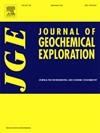Identifying key uranium sources in mine water: Open pit wall rock leaching and groundwater contributions in Leveäniemi open pit
IF 3.3
2区 地球科学
Q1 GEOCHEMISTRY & GEOPHYSICS
引用次数: 0
Abstract
Uranium (U) release from mining is an environmental concern due to U's chemical toxicity and radioactivity. In Sweden, U is classified as a river basin-specific pollutant (RBSP), emphasizing the need to minimize its release from mining activities. This study aims to trace the sources of U contributing to elevated concentrations in mine water from Leveäniemi open pit, Northern Sweden, to inform point-source prevention measures to mitigate U release. The study investigates U leaching rates from key rock types forming the open pit walls and evaluates groundwater entering the open pit through drainage pipes and fractures as a potential source of U. Minewall weathering stations showed higher U leaching rates from pegmatites compared to other rock types. The pegmatite station where uraninite was the predominant mineral had a leaching rate averaging 1800 μg/m2/wk, compared to 430 μg/m2/wk at the station where pyrochlore was the predominant U mineral and uraninite occurred as inclusions in pyrochlore. However, pegmatites cover a small area of the exposed surface in the open pit compared to trachyandesite, which leached at a lower average rate of 30 μg/m2/wk. Groundwater entering the open pit through fractures and drainage pipes was also identified as a significant source of U in the mine water, further influencing mine water U concentrations. Careful handling of pegmatite-containing waste rock is essential to prevent increased U leaching in both the open pit and waste rock dumps. This study highlights the importance of identifying rocks with high U release potential before exposure during mining. Additionally, understanding the distribution of these high U-release rock types along groundwater flow paths can also help to predict groundwater U concentrations and inform site-specific management strategies to mitigate U contamination in downstream recipients.
确定矿水中关键铀源:Leveäniemi露天矿围岩浸出及地下水贡献
由于铀的化学毒性和放射性,开采过程中铀的释放是一个环境问题。在瑞典,铀被归类为流域特定污染物(RBSP),强调需要尽量减少其从采矿活动中释放。本研究旨在追踪导致瑞典北部Leveäniemi露天矿矿水浓度升高的U的来源,为点源预防措施提供信息,以减轻U的释放。该研究调查了形成露天矿壁的主要岩石类型的U浸出率,并评估了通过排水管和裂缝进入露天矿的地下水作为U的潜在来源。矿井壁风化站显示,与其他岩石类型相比,伟晶岩的U浸出率更高。以铀为主要矿物的伟晶岩站的平均浸出率为1800 μg/m2/wk,而以焦绿石为主要矿物、铀以包裹体形式出现在焦绿石中的站的平均浸出率为430 μg/m2/wk。然而,伟晶岩覆盖一个小区域的暴露面露天trachyandesite相比,淋溶在一个较低的平均利率的30μg / m2 /周。通过裂隙和排水管进入露天矿的地下水也是矿井水中U的重要来源,进一步影响矿井水中U的浓度。小心处理含伟晶岩的废石对于防止露天矿和废石堆中U浸出的增加至关重要。该研究强调了在开采暴露前识别高铀释放潜力岩石的重要性。此外,了解这些高释放铀的岩石类型沿地下水流动路径的分布也有助于预测地下水铀浓度,并为特定地点的管理策略提供信息,以减轻下游接受者的铀污染。
本文章由计算机程序翻译,如有差异,请以英文原文为准。
求助全文
约1分钟内获得全文
求助全文
来源期刊

Journal of Geochemical Exploration
地学-地球化学与地球物理
CiteScore
7.40
自引率
7.70%
发文量
148
审稿时长
8.1 months
期刊介绍:
Journal of Geochemical Exploration is mostly dedicated to publication of original studies in exploration and environmental geochemistry and related topics.
Contributions considered of prevalent interest for the journal include researches based on the application of innovative methods to:
define the genesis and the evolution of mineral deposits including transfer of elements in large-scale mineralized areas.
analyze complex systems at the boundaries between bio-geochemistry, metal transport and mineral accumulation.
evaluate effects of historical mining activities on the surface environment.
trace pollutant sources and define their fate and transport models in the near-surface and surface environments involving solid, fluid and aerial matrices.
assess and quantify natural and technogenic radioactivity in the environment.
determine geochemical anomalies and set baseline reference values using compositional data analysis, multivariate statistics and geo-spatial analysis.
assess the impacts of anthropogenic contamination on ecosystems and human health at local and regional scale to prioritize and classify risks through deterministic and stochastic approaches.
Papers dedicated to the presentation of newly developed methods in analytical geochemistry to be applied in the field or in laboratory are also within the topics of interest for the journal.
 求助内容:
求助内容: 应助结果提醒方式:
应助结果提醒方式:


